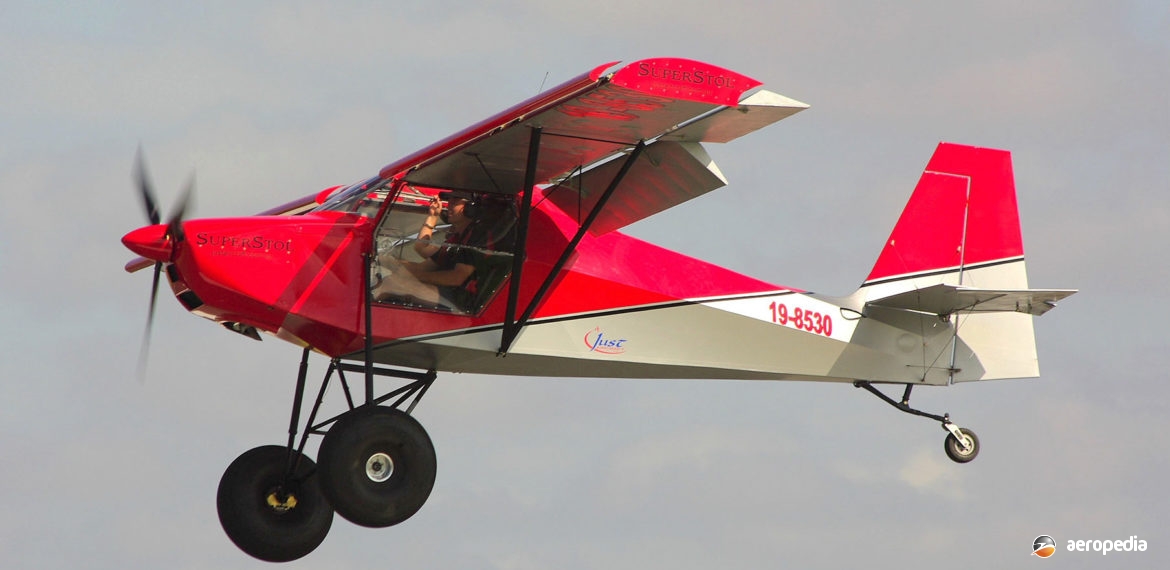Photograph:
Just Aircraft SuperSTOL 19-8530 (c/n JA392-06-14) at Avalon, VIC in February 2015 (David C Eyre)
Country of origin:
United States of America
Description:
Two-seat light sport STOL monoplane
Power Plant:
One 80 kw (100 hp) Rotax 912ULS four-cylinder horizontally-opposed liquid-and-air-cooled engine
Specifications:
- Wingspan: 9.53 m (30 ft 2 in)
- Length: 6.16 m (20 ft 2 in)
- Height: 2.4 m (7 ft 8 in)
- Wing area: 13.56 m² (147 sq ft)
- Never exceed speed: 209 km/h (130 mph)
- Cruising speed: 161 km/h (100 mph)
- Max rate of climb: 305 m/min (1,000 ft/min)
- Stalling speed power off, no flaps: 60 km/h (37 mph)
- Stalling speed with 40º flaps: 51 km/h (32 mph)
- Take-off roll: 30 m (100 ft)
- Landing roll: 30 m (100ft)
- Fuel capacity: 102 litres (22 Imp gals)
- Empty weight: 353 kg (779 lb)
- Useful load: 350 kg (771 lb)
- Full fuel payload weight: 276 kg (609 lb)
- LSA gross weight: 599 kg (1,320 lb)
- Max loaded weight: 703 kg (1,550 lb)
History:
The Just Aircraft SuperSTOL was a development of the Company’s Highlander, developed for the amateur-built market. It was designed and marketed by Just Aircraft of Walhalla, South Carolina, USA, the aircraft being supplied in kit form. The new design made its first appearance before the public at the Experimental Aircraft Association (EAA) event at Oshkosh, Wisconsin in 2012 and demonstrated its STOL ability when Messrs Woodland and Schmitt demonstrated its performance. Although new at the time, it had in fact been on the Company’s drawing board for ten years. It was aimed at the market for a simple to build and fly bush plane.
Similar in appearance to the Highlander, the aircraft had an undercarriage similar in design to that of the Pilatus Porter, being an A-frame which incorporated shock absorbers similar to those found on off-road trucks and SUVs. It had slats which extended automatically whenever the airspeed got below 102 km/h (63 mph) which enabled the aircraft to continue flying at a higher angle of attack and, in turn, at a slower airspeed. It was also fitted with tundra tyres, Fowler flaps and a re-designed tailplane. Seating was for two side-by-side in an enclosed cockpit. It had a conventional tailwheel undercarriage and an engine in a tractor configuration.
Construction of the fuselage was from welded 4130 steel tube. The wing had an aluminium spar and ribs, covered in aircraft fabric and supported by V-struts with jury struts. The wings could be folded for ground transportation or storage without disconnecting the fuel lines or control connections.
A range of engines could be installed, including the Rotax series, ie the 912UL of 60 kw (80 hp), the 75 kw (100 hp) 912ULS, the Rotax 912iS, the 86 kw (115 hp) Rotax 914, the Jabiru 2200 of 60 kw (80 hp), the Jabiru 3300 of 90 kw (120 hp), and the 60 kw (80 hp) Volkswagen.
First example of the type seen in this region arrived at Timaru, New Zealand on 6 December 2013. This aircraft became ZK-RIM (c/n JA-272), being fitted with a Rotax 914UL2 engine driving a Kiev propeller. This was followed by a further example which became ZK-CVV (c/n JAE-297) in December 2014.
First example in Australia became 19-8530 (c/n JA392-06-14) with Recreational Aviation Australia (RAA), being shown at the Australian International Air Show at Avalon, VIC in February 2015.

